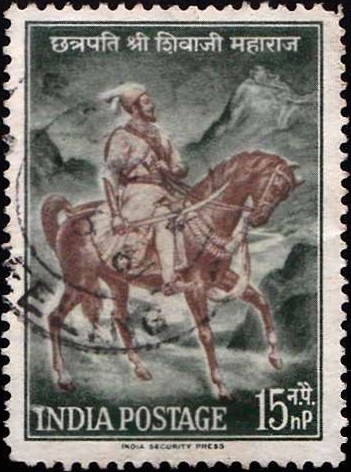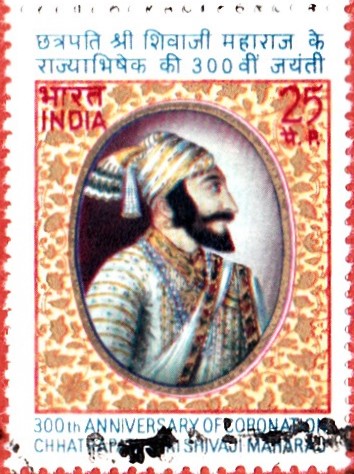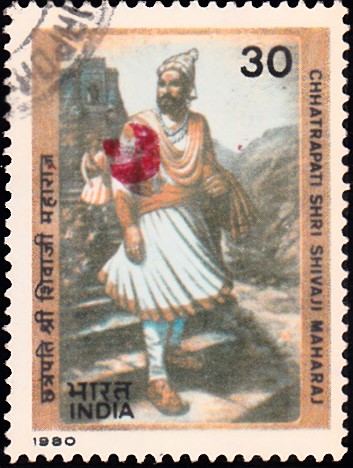
Chatrapati Shri Shivaji Maharaj 1961
A commemorative postage stamp on Maratha emperor, Chhatrapati Sivaji I, fought against Adilshahi sultanate of Bijapur and Mughal emperor, Aurangzeb :
 Issued by India
Issued by India
Issued on Apr 17, 1961
Issued for : The Posts and Telegraph Department deems it a great privilege to pay its tribute to the memory of this great son of India by issuing a special Commemorative stamp on the occasion of his birth anniversary.
Design : The design is based on a painting by Gopal D. Deuskar which adorns the Maharashtra Legislative Assembly, Bombay.
Designed by : Staff Artists of India Security Press, Nasik
Type : Stamp, Postal Used
Colour : Dark Brown and Olive Green
Denomination : 15 nP
Size : 3.91 X 2.90 cms.
Perforation : 13
Watermark : All over multiple “Lion Capital of Asoka“
Number printed : 2.5 million
Set : 35 stamps per issue sheet
Printing process : Photogravure
Name : Shivaji Bhonsle I
Born on Feb 19, 1627 at Shivneri Fort, Pune, Maharashtra, India
Died on Apr 3, 1680 at Raigad Fort, Maharashtra, India
About :
- The name of CHHATRAPATI SHIVAJI has been a source of inspiration not only to old and young but also to all freedom fighters in this country. His brave and daring deeds have been narrated in countless stories and songs in several Indian languages. A great patriot, a great soldier and a great ruler, Shivaji‘s fame rests on the successful struggle he waged against overwhelming odds for the liberation of his homeland and for restoring dignity and respect to his people.
- Shivaji was born in April 1627 at Shivneri, a hill-fort in the district of Poona. His father Shahaji Bhosle was a doughty warrior, whose services were considered valuable even by the Muslim rulers. From the Sultan of Bijapur he obtained a small jagir around Poona where young Shivaji grew up.
- Two persons influenced the young boy’s character and career – his mother Jijabai and his Dewan, Dadaji Kondadeo. Jijabai was a woman of austere and religious temperament. Her constant companionship, advice and reading of Hindu scriptures and especially the Mahabharata and the Ramayana, instilled in young Shivaji‘s mind a burning hatred for wrong and injustice, a pride in the past glory of his country and an intense desire to liberate it from foreign rule. Dadaji Kondadeo taught young Shivaji reading, writing, the use of arms and – what is essential for a ruler – the successful management of his jagir.
- Shivaji commenced expanding his jagir early. In 1644, he occupied the fort of Sinhagad overlooking the town of Poona; three year later, he seized the forts of Torna, Chakan, Purandhar, built others and brought the surrounding country under his control. In the fort of Torna he discovered buried treasure with the help of which he increased his army. Reports spread that Shivaji had divine support in his mission and men flocked round his banner from all quarters. The Adil Shahi forces sent out to destroy him were decoyed and defeated in the ravines of the hilly country. Afzul Khan‘s army was dispersed, and the general who followed him wasted his time in hopeless siege and pursuit.
- Shivaji soon faced a greater danger. His career to conquest brought him in contact with the mighty Moghul Empire that was trying to absorb the southern Kingdoms, and a struggle began which lasted over half a century. By a stratagem the Maratha defeated Shaista Khan in 1663. When pressed hard by his successor, Raja Jai Singh, Shivaji surrendered half of his Kingdom and visited the Moghul Emperor at Agra. Suspecting foul play he escaped from Agra, returned to Maharashtra and waged a relentless war to drive the enemy out of his country.
- By 1674, Shivaji was master of an extensive territory and was crowned the same year with resplendent ceremonial at Raigad.
- In the remaining six years of his life, he overwhelmed his foes, led armies in the Karnatak and gave much thought to the organization of his administration. He died on 4th April 1680.
- Shivaji took care to put his administration in order. Though the burden of administration was divided among eight ministers, Shivaji was his own prime minister and guided the work of his cabinet. Throughout his reign, Shivaji showed great solicitude for the welfare of his people, especially the peasants.
- The historian Jadunath Sarkar has this to say of Shivaji, “His reign brought peace and order to his country, assured the protection of women’s honor and the religion of all sects without distinction, extended the royal patronage to the truly pious men of all creeds and presented equal opportunities to all his subjects by opening the public service to talent irrespective of caste and creed. This was the ideal policy for a State with a composite population like India“.








[…] He was subsequently christened ‘Sivaji‘ after his outstanding portrayal of the great Maratha warrior in the play Sivaji Kanda Hindu […]
[…] thereby generating a renaissance of sorts and reinforcing the Maratha identity. A contemporary of Shivaji, he propagated compassion, forgiveness, peace and […]